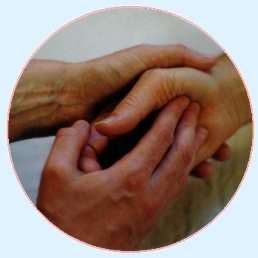Therapeutic Massage and Diabetes 1. 1
by Mary Kathleen Rose
[Clients with this serious disease may often be helped by massage,
if the proper procedures are followed. ]
I had recently graduated from massage school in 1985, and was in the process of moving. Many factors in my life were in flux at the time, so I paid little attention to the physical symptoms that presented themselves over a period of several weeks. As these symptoms persisted--fatigue, excessive thirst and frequent urination--I knew I needed medical help.
 Matters worsened as I became weaker, developing abdominal pain, nausea and shortness of breath. By the time I was taken to the hospital, I was barely conscious, having developed a life-threatening condition known as diabetic ketoacidosis. I was diagnosed with Type 1 diabetes.
Matters worsened as I became weaker, developing abdominal pain, nausea and shortness of breath. By the time I was taken to the hospital, I was barely conscious, having developed a life-threatening condition known as diabetic ketoacidosis. I was diagnosed with Type 1 diabetes.
While still in intensive care, I learned I would need to take injections of insulin and test my blood sugar several times a day for the rest of my life. With the support of family, friends and progressive medical care, I have learned to live well with this complex disease. Complementary medicine, including massage therapy, always has been a significant part of my health care.
Even as a newly diagnosed diabetic, I felt tremendous changes in my body. In the short term, I began to feel increasing strength as I slowly recovered from the diabetic ketoacidosis. Insulin by injection is different than the body's own insulin. In some ways I felt as if I had a new body, running on a new and different fuel. It was as if the texture of my muscles and fascia had changed, becoming a little more dense. I had just completed a year-long training in massage therapy, and some of these changes were observable by friends who I had met as fellow massage therapy students.
Over the years I know I have benefited in many ways from receiving massage. I currently teach therapeutic massage in a number of massage schools and medical settings, and have been in a position to educate massage therapists and other health professionals about the benefits of massage for diabetics, as well as to inform them of special concerns when working with this population.
Massage-Specific Benefits
There are many benefits of massage therapy for people with diabetes. Most of these would be similar to the benefits of massage for the general population, but I want to emphasize the following advantages, which are of particular interest for diabetics.
Relaxation: The value of basic relaxation cannot be overemphasized. Living with diabetes is inherently a stressful condition. Fluctuating blood sugar levels put tremendous strain on the body's systems. The practical demands of balancing intake of insulin or oral medications, blood glucose monitoring, nutrition and exercise can seem like a daunting task for many. Worry about complications of the disease, or anxiety relating to work or interpersonal relationships, can add to the picture of stress. By calming the nervous system, massage can bring a much-needed rest and an assuring sense of well-being to the body. Skillfully applied touch can have a profound effect on body chemistry, decreasing the production of stress hormones, with resulting beneficial effects to blood sugar levels.
Circulation: Massage increases the circulation of blood and lymph, facilitating the transport of oxygen and other nutrients into the body's tissues. Improved circulation allows for more efficient uptake of insulin by the cells. Circulation is often impaired in diabetics due to the damaging effects of elevated blood sugar levels on the cells of the body. Massage of the hands and feet can be particularly beneficial.
Myofascial Effects: Massage works directly with the muscles (myo) and connective tissues (fascia), helping to facilitate greater mobility in the body. This is especially important for the diabetic because elevated blood sugars cause a thickening of connective tissue, which in turn affects mobility and elasticity of the myofascial system. This can be noted in general levels of stiffness in muscles, tendons and ligaments, as well as decreased range of motion in the joints. Stress hormones also contribute to chemical changes in the connective tissue, causing a stickiness between the layers of fascia. Massage therapy can significantly counter this effect. Range of motion, stretching and regular exercise are also important to help encourage flexibility and health of the myofascial system.
A Diabetes Clinic
Since late 1999, I have supervised a clinic where student interns give massage to people with diabetes. This has been a tremendous opportunity to observe the benefits of therapeutic massage, and to record changes in blood sugars during the course of a session. I share this information so that it can be of use to diabetics who are considering receiving massage therapy, as well as to massage therapists and other health-care professionals involved in diabetes education.
The students who participate in the clinic have all received their basic instruction in Swedish or integrative therapeutic massage. They are in the final quarter of their massage school training, and this clinic provides them the opportunity to practice their skills, offering massages free of charge to the clients as part of community service. All protocols of professional massage practice are observed, including medical history intake interview, observation of client confidentiality and use of appropriate techniques.
The client is unclothed to their level of comfort, always draped for modesty and warmth, and a light, unscented lotion or oil is applied with the massage strokes. Basic strokes of Swedish massage are used, including gliding, kneading and wringing. Also used are acupressure strokes of general compression and specific contact pressure. The therapist responds to the client's feedback in order to address specific needs and preferences for areas of the body massaged, depth of pressure applied and types of strokes used.
Most of the recipients of massage have been Type 1 diabetics, ranging in age from 25 to 50 years old. Prior massage experience has been varied, but all have been enthusiastic to receive the massages. Sessions last about an hour, with 45 to 50 minutes being actual hands-on time. Each person is required to test blood glucose levels before the session, noting quantities of food eaten and times of ingestion prior to the massage. We also note the time and amount of the last injection of insulin (or bolus of insulin if using an insulin pump). Each person also tests their blood sugar again after the session.
Changes In Blood Glucose Levels
 To date, more than a dozen different massage therapy interns have given massage in the diabetes clinic. More than 20 different diabetics have received massage, some receiving several sessions over a period of several weeks or months. It has been an enjoyable experience for all participants. Those receiving massage have reported greater levels of physical and emotional comfort after the session than before.
To date, more than a dozen different massage therapy interns have given massage in the diabetes clinic. More than 20 different diabetics have received massage, some receiving several sessions over a period of several weeks or months. It has been an enjoyable experience for all participants. Those receiving massage have reported greater levels of physical and emotional comfort after the session than before.
Because of blood glucose testing, we are getting some useful data on the changes that occur in blood glucose levels during massage. My preliminary observations are this: Massage therapy tends to lower blood sugar levels by approximately 20 to 40 points, other factors being equal. This is not a scientifically controlled study by any means. (A truly controlled study with Type 1 diabetics could be a near impossibility, since there are so many factors that influence blood sugar.)
But by tracking blood glucose before and after the session, I can clearly demonstrate that blood sugars can and do change significantly in an hour, for whatever reason. This is very important information for massage therapists who need to be alert to the dramatic changes that can occur in the blood glucose levels of diabetics during massage therapy. I teach this to my students as an important safety issue.
In the clinic, we noted changes of as much as a 100-point decrease in an hour, as well as a 100-point increase! The more dramatic decreases could be partly accounted for by recent injections of insulin, or by vigorous exercise in the hours prior to the massage session. The dramatic increases could be due to the failure of the client to take his or her required dose of insulin. Or they may have eaten food not covered by adequate insulin. But as stated earlier, moderate drops of 20 to 40 points were the norm.
The student interns giving the massages were surprised by these changes in blood sugar levels. So were some of the diabetics. Seeing the numbers helped impress upon both interns and diabetics the importance of blood glucose testing. Naturally, people tend to be relaxed and sometimes a little disoriented after receiving a massage. It is imperative that the possibility of a serious low blood sugar be ruled out before a client is allowed to leave the premises.
When people with diabetes receive repeated sessions, they can begin to understand their own patterns of response to massage, and plan accordingly. For example, I know that I tend to drop around 40 points during a relaxing session of massage. So if I am 100 points or less before the session, I'll drink a small glass of juice beforehand, or maybe have it in the room to drink during the session.
If I have a reading ranging from 140 to 160 points, I will eat nothing, knowing I will drop into a more desirable range during the session. If higher than 160 points, I may take an extra injection of insulin, being careful to account for the likely drop due to massage. Sometimes I have observed the blood glucose lowering effect of the massage lasts for several hours. It is wise to continue with regular testing.
My example is only one. Each diabetic may have a different response. And often, even for the experienced recipient of massage, changes can be unpredictable. Again, I emphasize the importance of blood glucose monitoring.
 Mary Kathleen Rose is a licensed massage therapist with a B.A. in integrative healing. She has been actively involved in the holistic health field for more than 25 years, teaching massage and wellness education in massage schools and medical settings. She is the developer of Comfort Touch, a style of massage appropriate for the elderly and ill, and is the supervisor of the massage therapy program at Hospice of Boulder County in Boulder, Colorado. She is a founding member of the Boulder Valley Diabetic Support Group, which has provided education and support for diabetics and their families since 1987. She can be reached at: 303-651-9374, or at: rosevine@comforttouch.com.
Mary Kathleen Rose is a licensed massage therapist with a B.A. in integrative healing. She has been actively involved in the holistic health field for more than 25 years, teaching massage and wellness education in massage schools and medical settings. She is the developer of Comfort Touch, a style of massage appropriate for the elderly and ill, and is the supervisor of the massage therapy program at Hospice of Boulder County in Boulder, Colorado. She is a founding member of the Boulder Valley Diabetic Support Group, which has provided education and support for diabetics and their families since 1987. She can be reached at: 303-651-9374, or at: rosevine@comforttouch.com.
Bibliography
Rose, Mary Kathleen. The Gift of Touch--Comfort Touch: Massage for the Elderly and the Chronically Ill. Boulder, Colorado: Hospice of Boulder County, 1996.
Thomas, Clayton (editor). Taber's Cyclopedic Medical Dictionary, 17th Edition. Philadelphia: Davis Company, 1993.
Walsh, John, Ruth Roberts and Lois Jovanovic-Peterson. Stop the Rollercoaster: How to Take Charge of Your Blood Sugars in Diabetes. Torrey Pines, California: Torrey Pines Press, 1996.
A COMPLICATED DISEASE
Diabetes is a disease of impaired carbohydrate metabolism, which results from inadequate production or utilization of the hormone insulin. This vital substance is necessary to convert food into energy, by facilitating the transfer of glucose (sugar) from the bloodstream into the body's cells. Of the 16 million people in the United States with diabetes, most have a genetic predisposition to the disease, and can be categorized into one of the following types:
Type 1 Diabetes (Insulin Dependent Diabetes Mellitus, or IDDM): Affects 10 to 15 percent of the total number of diabetics. Because of damage to the insulin-producing islet cells of the pancreas, little or no insulin is available. Often, the onset of the disease occurs following significant physical or emotional stress, usually in childhood or early adult life. These individuals must take regular injections of insulin.
Type 2 Diabetes (Non-Insulin Dependent Diabetes Mellitus, or NIDDM): Affects more than 85 percent of the total number of diabetics, and is more prevalent in the older population. In these people, the pancreas is producing insulin, but the cells that use insulin are resistant to it. Type 2 diabetics may take one or more oral medications designed to decrease insulin resistance or enhance the cells' sensitivity to insulin. They may also need to take insulin by injection.
Symptoms: While the types have different pathologies, they have the same common symptom--high levels of glucose in the blood. Essentially, the cells become starved for energy, so the person is fatigued. Excess sugar spills into the urine, causing frequent urination and excessive thirst. The disease can be diagnosed with a simple blood test to determine the blood glucose level.
Complications: Over time, elevated glucose levels lead to complications of the disease, by causing damage at the cellular level. Cells especially prone to damage are in the eyes, kidneys, heart, blood vessels and nervous system. Without good blood sugar control, the diabetic becomes more vulnerable to retinopathy, neuropathy, as well as kidney and heart disease. Other changes may occur in the connective tissue of the body, leading to thickening or stiffening of the fascia surrounding the muscles and organs.
Treatment: Treatment of diabetes involves normalization and maintenance of healthy blood glucose levels. The diabetic must be conscientious to maintain near-normal blood glucose levels (80 to 120 mg/dl) by balancing nutrition, exercise, appropriate use of medications (insulin or oral medications), and management of stress. Diabetics use test strips and monitors to determine their blood glucose levels (BGs). If the BGs are low, they can eat or drink carbohydrates to bring them back into the normal range. If they are high, they may need to inject more insulin, or otherwise adjust their treatment.
With appropriate medical treatment and careful attention to maintaining a healthy lifestyle, the person with diabetes can live a long, productive life. Massage therapy can be a useful and enjoyable aspect of overall care. Just what are the specific benefits of massage for the diabetic? What does the massage therapist need to know to successfully and safely treat the person with diabetes? Because of my personal experience as a diabetic and as a massage therapist, I feel I am in a unique position to share my observations. My initial experience in the hospital taught me the value of touch. While in the emergency room and intensive care, I was so grateful when someone, a friend or medical staff person, would touch me. Unable to speak or communicate my fears, initially it was just helpful to feel the comfort and assurance of touch.

COMFORT TOUCH DVD - NOW AVAILABLE
 This beautifully produced video introduces the viewer to the principles and techniques of Comfort Touch, a nurturing form of acupressure massage designed to be safe and appropriate for the elderly and the ill. Drawing on her many years of experience practicing and teaching this work in home-care and medical settings, Mary Kathleen Rose shares the essential elements of Comfort Touch with demonstrations of its applications in the seated, supine and side-lying positions.
This beautifully produced video introduces the viewer to the principles and techniques of Comfort Touch, a nurturing form of acupressure massage designed to be safe and appropriate for the elderly and the ill. Drawing on her many years of experience practicing and teaching this work in home-care and medical settings, Mary Kathleen Rose shares the essential elements of Comfort Touch with demonstrations of its applications in the seated, supine and side-lying positions.
This program will inspire the viewer - whether healthcare professional or family caregiver - to offer the benefits of touch to those for whom conventional massage may cause discomfort or even injury. While Comfort Touch provides soothing relief for the elderly and the ill, it can enhance the quality of life for anyone in need of a caring touch.
Includes 40-page Video Guide, complete with Principles and Techniques of Comfort Touch, Benefits of Comfort Touch, Precautions in the Use of Touch and Self-Care Exercises for the Caregiver. Yours for $29.00 plus shipping.
Breast
Cancer? Breast Health!
The Wise Woman Way
by Susun S. Weed
Foreword by Christiane Northrup, MD
380 pages, index, profusely illustrated.
Foods, exercises, and attitudes to keep your breasts healthy.
Supportive complimentary medicines to ease side-effects of
surgery, radiation, chemotherapy, or tamoxifen.
Retails for $21.95
Read a Review
Read some excerpts:
Mammograms - Who Needs Them? from Breast Cancer? Breast Health!
Using Herbs Safely from Breast Cancer? Breast Health!
My Anti-Cancer Lifestyle from Breast Cancer? Breast Health!
Order BREAST CANCER? BREAST HEALTH! in our Bookshop
What a gift to women of all ages! This
book helped me overcome my fear of what I might discover during
self-examination. I am so grateful that this book came my
way and I am healthier in mind, body, and spirit thanks to
Ms. Weed's wise words! If I could, I would give a copy of
this book to every woman in the world!
The
Woman's Belly Book:
Finding
Your Treasure Within
by Lisa
Sarasohn
144 pages, 20 illustrations lay-flat perfect binding.
The Woman's Belly Book is a guide to activating the source energy
concentrated in your body's core. With the experience of 12 gentle
breathing exercises, 7 invigorating yoga moves, and 15 playful ways
to befriend your belly you'll know the satisfaction of coming home
to yourself.
Price: $15.95
"This warm and friendly book is filled with womb wisdom,
belly laughs, gut feelings, and pelvic power. It is--as subtitled--a
guide to buried treasure. I recommend it highly."
--Susun Weed
Read a review
Order THE WOMEN'S BELLYBOOK in our Bookshop







